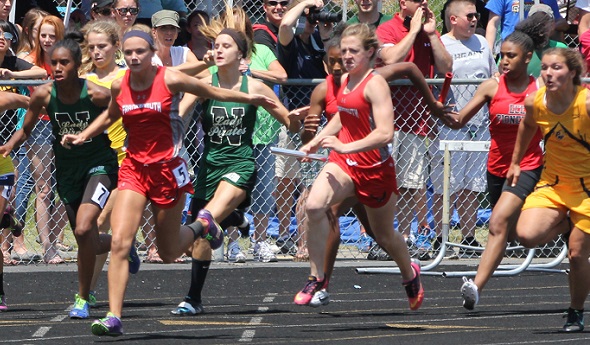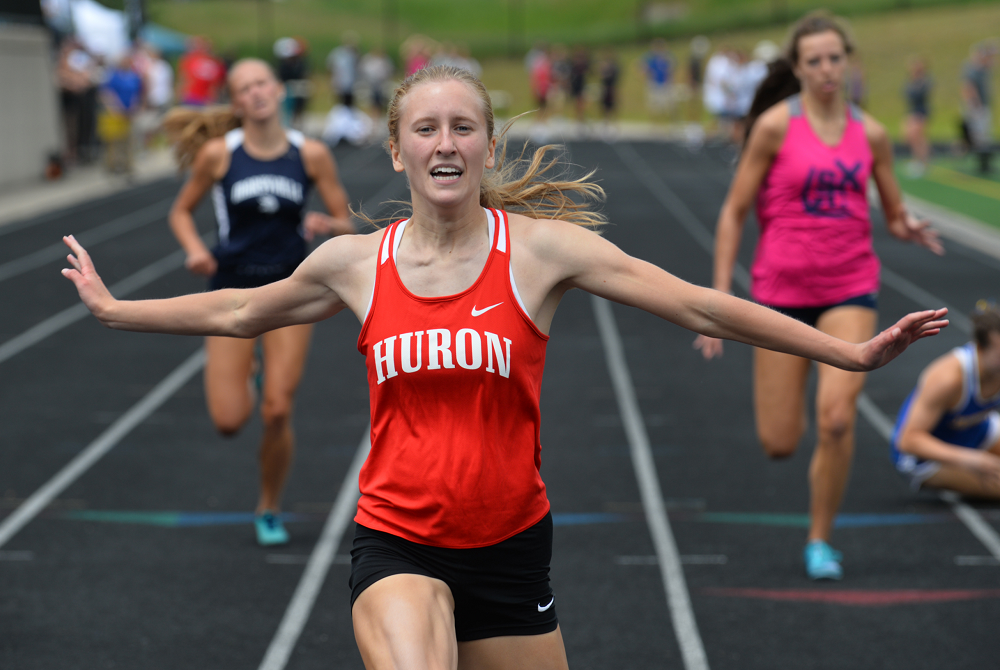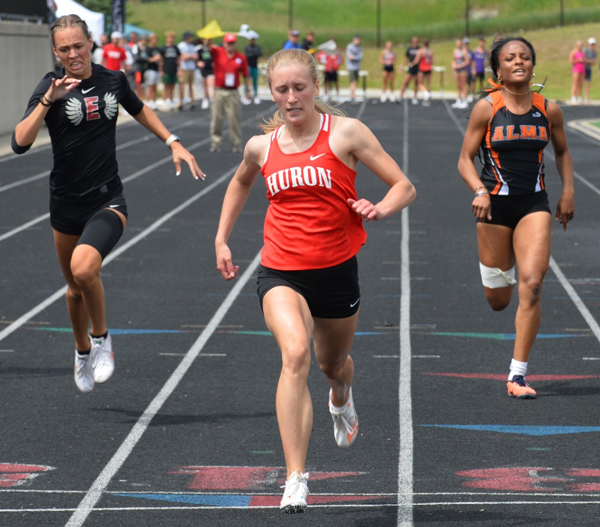
Frankenmuth Takes Back D3 Supremacy
May 31, 2014
By Butch Harmon
Special to Second Half
COMSTOCK PARK – After coming up short in its bid to repeat as MHSAA champions at last year’s Lower Peninsula Division 3 Girls Track and Field Finals, Frankenmuth was determined to not be denied this time.
With a squad that featured six top seeds and balance on the track and in the field events, the Eagles this time captured the title in impressive fashion as they outlasted last year’s champions, Pewamo-Westphalia.
The MHSAA title was the second in three years for Frankenmuth and fourth in the last six years for a program that is setting the standard for girls track and field in Division 3.
Sprinter Angie Ritter was one of the leaders. The senior, who was part of the title-winning team as a sophomore, was not about to let her career end without hoisting another championship trophy.
“I was real happy with what our team did,” Ritter said. “As a team we all performed up to par. Last year we had a few fallouts, but this year everyone did what was expected. We all came into the season with positive attitudes, and we talked about winning state this year.”
The day went according to form for the Eagles, who knew before the meet was over that they had won.
“By the time we got to the four by four (1,600 relay) we knew we had it,” Ritter said. “We were up by 26 points with one event to go, and we knew we got it.”
She did her part to help. Ritter, who will be running for Grand Valley State University next season, won both the 100 and the 200-meter dashes and was a member of the 800 relay team that also finished first.
“I was just hoping to get first in both the 100 and the 200,” Ritter said. “Winning a state championship says it all. I was pretty happy to win it all.”
Ritter also removed her sister’s name from the school record book in the process as her time in the 100-meter dash was three-tenths of a second faster than her sister Kelsey Ritter’s previous Frankenmuth best.
Angie Ritter was not the only Eagles standout to win a pair of individual titles. Junior Sydney Bronner captured the 100 hurdles and high jump, and like Ritter was also a member of the 800 relay champ.
Bronner placed in high jump last year but was determined to take the title and also set a new personal best of 5-6, something she accomplished in the final. That personal best also tied the LP Division 3 meet record.
“I took third last year,” Bronner said. “I wanted to take first this year. I tried seven or eight times at 5-6, and this time I finally did it. I was more confident this year and I also have improved my form.”
Second-place Pewamo-Westphalia didn’t let this year’s title go without a fight. The 400 relay team of seniors Jenna Thelen, Sasha Platte, Kenzie Wieber and junior Gabbie Hummel took first, and in the process set a new school record. For Thelen, Platte and Wieber, it was their final time competing together.
“It really helps having three seniors on the team,” Thelen said. “This was the last race for the three of us, and we wanted to go out with a win.”
“It was a blessing in itself,” Platte added. “We did great today. We did a lot of work for this, and our coaches helped lead us to this.”
Elkton-Pigeon-BayPort senior Kayla Deering wrapped up her high school career in a big way. A two-time MHSAA champion in the shot put, Deering closed with a third straight title with a put of 44-11. Deering, who will compete at the University of Michigan next season, also placed sixth in the discus.
“I was satisfied,” Deering said. “I really wanted the state record, but I was satisfied to win a third state title. I just tried to stay focused. I’m content, but it would have been nice to set a new personal best here.”
Manistee’s Annie Fuller battled through the heat of the afternoon to capture a pair of titles for a second consecutive year. A junior, Fuller won the 800 as a freshman. Last season she won the 800 for a second straight year and also added the 1,600 title. Saturday she again took titles in the 800 and 1,600.
“The heat didn’t help much,” Fuller said. “There was also definitely more pressure this year trying to repeat. The competition is real strong and you don’t want to lose.”
Fuller set personal records in both races and also helped Manistee finish third overall in the 1,600 relay, running the anchor leg.
Napoleon junior Kaniya Weatherspoon had only one jump in the long jump competition but she made it count. Weatherspoon jumped 17-4½ on her first attempt, and that leap was good for first place. She was scratched on her next two jumps as she suffered tightness in her quad muscle and wanted to save herself so she could contribute to the team score in other events. Weatherspoon went on to finish fifth in the 200 and helped Napoleon’s 400 and 800 relay teams finish among the top five. Those efforts enabled Napoleon to finish in fourth place overall.
PHOTO: Frankenmuth's Cadi Palmreuter (second from left) takes the baton from teammate Rebekah Barger during the 400 relay Saturday. The Eagles finished second in this race but won the meet. (Click to see more from RunMichigan.com.)

Multi-Sprint Champ Racing to Finish Huron Career Ahead of the Rest Again
By
Keith Dunlap
Special for MHSAA.com
May 25, 2023
NEW BOSTON – If there was one thing Elizabeth Anderson took pride in elementary school, it was simply showing that she could outrun everyone in sight.
 In fact, Anderson has an explanation for all the success she had in those playground races.
In fact, Anderson has an explanation for all the success she had in those playground races.
“Dominance when you are in elementary school,” Anderson quipped. “I don’t think I ever had a nickname. I just think everyone knew I was fast.”
Years later, pretty much everyone who follows track & field in the state of Michigan can attest to that.
A senior for New Boston Huron, Anderson has been faster than most other competitors in the state during her three-year high school career (with her freshman season in 2020 canceled due to COVID-19).
Last year, Anderson won titles at the Lower Peninsula Division 2 Finals in the 200-meter (25.07) and 400-meter (56.28) dashes, and was runner-up in the 100-meter dash (12.23).
Often, top sprinters focus on one or two of those three races. But Anderson is certainly a different breed of sprinter because she does all three.
In fact, she holds school records in all three of those events, and if all that weren’t enough, Anderson is a part of all three sprint relay teams.
“It is hard to give her events off,” said New Boston Huron head girls track coach Danielle Lobato.
Despite the different styles the 100, 200 and 400-meter dashes present, Anderson said there usually isn’t much adjusting when she goes from one of those races to another.
 The strategy is simply, “Let’s beat the other girls to the finish line.”
The strategy is simply, “Let’s beat the other girls to the finish line.”
“I don’t really go into each race changing up how I would run,” she said.
While enjoying and succeeding in all three races, Anderson said she actually does have a favorite among them.
“I would say the 400 is probably my favorite,” she said. “Even though it hurts, it’s satisfying to see how much you can get your time down in the 400 compared to any other race.”
Anderson said she started running track in sixth grade, but really got serious about it during the summer after her sophomore season, when she was invited to run for a local club.
Eventually, that led to her competing over the winter in indoor events.
She lived and breathed track so much that last fall, she decided to not run cross country so she could focus on a weightlifting regimen aimed at developing more leg strength.
“Once I started doing summer track, I realized I wanted to be doing this all the time,” she said.
Lobato said oftentimes in practice, Anderson is a de facto coach, given there is no better person she can think of for the younger runners on the team to learn from.
“I can’t always demonstrate these things I’m trying to teach,” she said. “You get to see it in real life (from Anderson), not in a YouTube video.”
After winning the 100, 200 and 400-meter dashes at her Regional meet last week, Anderson has her sights set on achieving the same trifecta of titles at next Saturday’s Finals in Grand Rapids.
Anderson has signed to run track at Michigan State, but has been plenty motivated to keep producing this spring in her final high school season.
“I’m really looking to defend my titles,” she said. “That is what is really motivating me to keep going. I want to keep in shape for the college season. I don’t want to lose any of the progress I have made. Ultimately, I just love running track.”
And since elementary school, Anderson has loved — and succeeded in — outrunning everyone else to the finish line.
“We knew we were getting something special,” Lobato said of when Anderson arrived in high school. “But you never expect this. All that she has accomplished is amazing.”
 Keith Dunlap has served in Detroit-area sports media for more than two decades, including as a sportswriter at the Oakland Press from 2001-16 primarily covering high school sports but also college and professional teams. His bylines also have appeared in USA Today, the Washington Post, the Detroit Free Press, the Houston Chronicle and the Boston Globe. He served as the administrator for the Oakland Activities Association’s website from 2017-2020. Contact him at [email protected] with story ideas for Oakland, Macomb and Wayne counties
Keith Dunlap has served in Detroit-area sports media for more than two decades, including as a sportswriter at the Oakland Press from 2001-16 primarily covering high school sports but also college and professional teams. His bylines also have appeared in USA Today, the Washington Post, the Detroit Free Press, the Houston Chronicle and the Boston Globe. He served as the administrator for the Oakland Activities Association’s website from 2017-2020. Contact him at [email protected] with story ideas for Oakland, Macomb and Wayne counties
PHOTOS (Top) New Boston Huron's Elizabeth Anderson clears the finish line during last season's LPD2 400 race. (Middle) Anderson, middle, outpaces the field to also win the 200. (Click for more from RunMichigan.com.)

